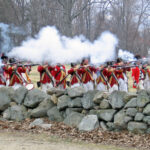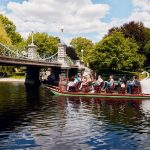Celebrating Christmas in Vermont
The most wonderful part of winter in New England is Christmas in Vermont. See how three towns – Grafton, Chester, and Woodstock – celebrate their own Christmas in Vermont.

Coffee By Design | Portland, Maine
Photo Credit : Katherine Keenan
Photo Credit : Sacco, Lisa

Photo Credit : Sacco, Lisa
Come Home to Chester | Christmas in Vermont
Chester (population 3,044) sits at the confluence of three state routes (five major roads all together). In winter, cars stream by heading north to Okemo Mountain. Few stop. If they did, they’d likely discover why Chester residents call their town “the Vermont you’ve been hoping to find.”
“I immediately felt the friendliness of people here,” reflects Canadian-born Jack Coleman, who launched Chester’s “Overture to Christmas” events more than 20 years ago. He’d been a writer, president of Haverford College, and head of a major foundation. Then he bought the 21-room Chester Inn, christening it “The Inn at Long Last.” Today the owners are Bret and Nancy Rugg, who have preserved its reputation for good food, refurbished its guestrooms, and revived the original name: The Fullerton Inn. “I don’t know where I’ll end up, but I hope it’s right here,” concludes Coleman, who still lives next door.
Chester consists of three villages, with its core along the stretch of Main Street (Route 11), flanked on one side by its mellow brick, original Academy and graveyard, and on the other side by the green, backed by a line of shops, restaurants, a church, a Masonic hall, and the inn. Folks who fork north onto Route 103 will find Chester Depot, a late-19th-century village centered around a brick railroad station (the terminus for the Green Mountain Flyer). Route 103 doglegs northwest at Stone Village (formerly North Chester), a striking double line of early-19th-century houses, all built from locally quarried granite. In the middle of the village an “Open” flag is usually out, marking the home of Bonnie’s Bundles Dolls.
“I want to meet the people who buy my dolls,” explains Bonnie Watters, who welcomes visitors into her parlor to inspect roughly 100 one-of-a-kind cloth dolls.
Nearby, watercolorist Jeanne Carbonetti greets visitors in the many-windowed Crow Hill Gallery, which she and husband Larry designed and built on a rise off above the meadows. It’s an ideal setting for her richly colored paintings.
The showroom at Tsuga Studios, squirreled up a back road on the western edge of town, is usually open by appointment only, but hosts an open house and holiday sale one weekend in December, when blown-glass Christmas ornaments festoon the rafters and seconds draw fans from afar. Glassmaker Nicholas Kekic is known for his deeply colored, elegantly simple pitchers and bowls.
Back near the green, Chester’s attraction for artists carries over to Baba-a-Louis Bakery. John McLure’s sticky buns, croissants, French loaves, and peasant breads are distributed throughout New England, but here you’ll also find his French pastries, including buche de Noel. The octagonal building, which McLure designed and built, features arches soaring 30 feet.
For many residents and visitors, Misty Valley Books, on the green, is the heart of Chester. This independent bookseller offers frequent author’s readings and hosts a “New Voices” weekend at a church in Stone Village in January, featuring first-time novelists. Past flyers for this event paper the walls in the store’s “Archives” (the bathroom), picturing a number of current best-selling authors.
“This store is an extension of ourselves,” explains Lynne Reed, when asked why Misty Valley also sells Persian carpets and offers French courses. (Husband Bill Reed has taught in Africa and France as well as in Vermont schools.) It’s also a place to find a trail map to the town’s hiking/snowshoeing trail.
Chester’s crossroads status is also part of its appeal, and visitors can choose from four nearby ski areas. If you’re celebrating Christmas in Vermont, don’t miss the fresh snow there.

Photo Credit : Sacco, Lisa
Grafton Turns Back the Clock | Christmas in Vermont
Arriving in Grafton (population 650) during snow season is like entering a Christmas card. Although it’s an easy drive to several ski resorts, Grafton on a wintry night seems a long way from anywhere. But serious cross-country skiers know Grafton. The 30-kilometer trail network at Grafton Ponds is meticulously groomed. Trails meander off from the warming hut, out over meadows, and up into the woods on Bear Hill, where there’s plenty more back-country skiing. The complex also offers rentals and great venues for tubing, ice skating, and snowshoeing.
Grafton’s attractiveness today owes as much to the Windham Foundation — incorporated in 1963 by a wealthy family with ties to the town — as it does to nature. The organization bought up most of the central village, buried the power lines, revived the general store, and then tackled the imposing three-story Old Tavern. Craftsmen renovated and winterized it, and even added an elevator, all while carefully preserving the building’s historic detailing.
The holidays are a busy time at the Grafton Village Cheese factory, producing some of Vermont’s best prize-winning cheddars. Visitors are welcome to learn how 6,000 to 10,000 gallons of buttery milk from Jersey cows are processed daily, from cutting the curd to waxing the wheels and blocks of cheese. Different colors connote age and flavor, and visitors are welcome to sample.
Within its few streets, Grafton offers a surprising amount to savor, especially once you adjust to its pace. Step into the vintage 1811 Butterfield House, now home to the town library. Stop by The Nature Museum and be amazed by the extent of its exhibits, both interactive and stuffed.
Then step into the Jud Hartmann Gallery and find yourself in the midst of lifelike Iroquoian and Algonkian warriors and chiefs. Hartmann is nationally known for his limited-edition bronze sculptures of the Woodland tribes of the 17th- and 18th-century Northeast. Then stroll around the corner to Hunter Artworks and on up the road to Gallery North Star, hung with a variety of New England landscapes.

Photo Credit : Sacco, Lisa
Woodstock’s Winter Welcome | Christmas in Vermont
“Summer people” began arriving in Woodstock, the shire town of Windsor County, in 1875, with the completion of a railroad trestle and spur line from White River Junction over Quechee Gorge. The town’s year-round resort status was assured in 1892 with the opening of the lavish Woodstock Inn, which drew guests from New York and Boston — even in winter for snowshoeing and skating. And then in 1934, America’s first rope tow began hauling skiers up Gilbert’s Hill.
By 1960, the Woodstock Inn was creaky and the town’s ski areas had been upstaged by nearby Killington but, luckily, Mary French, heir to the town’s largest and most historic estate, had in 1934 married Laurance Rockefeller, the man already largely responsible for creating more than 20 state and national parks and historic sites. Rockefeller zeroed in on “Mary’s hometown.” In the 1960s, he replaced the old inn and created the Woodstock Foundation as a nonprofit umbrella for community projects, such as burying power lines, renovating the Town Hall Theatre, and constructing a new covered bridge. He also restored Marsh-Billings Farm and donated it, along with his wife’s family mansion and forestland on Mount Tom, to the National Park Service.
Rockefeller died in 2004, but his Woodstock legacy continues to build. Recently his executors approved transfer of ownership of the Woodstock Resort Corporation — which includes, among other things, the newly renovated inn, the Woodstock Nordic Center, and the Suicide Six Ski Area (in South Pomfret) — to the Woodstock Foundation. And Woodstock is indeed most welcoming in winter. Alpine skiers have long known that Suicide Six is far gentler than its rugged name, and cross-country enthusiasts head to the beautifully groomed 1880s carriage roads climbing gently to the summit of Mount Tom. Across town, more extensive trails radiate from the Nordic Center and loop up into the woods on Mount Peg.
And then there’s the village itself. Each of its more than a dozen inns has its own story. Central and Elm streets showcase some of Vermont’s best artists and craftspeople and are home to venerable institutions such as F. H. Gillingham & Sons’ general store, operated by the same family for 108 years; Woodstock Pharmacy, with its basement trove of educational toys; and The Prince and the Pauper restaurant, featuring chef Chris Balcer’s genuinely Continental cuisine.
The annual Woodstock Wassail Weekend, Vermont’s most elaborate winter celebration, combines outdoor spectacle, indoor performances, and community events at which visitors feel genuinely welcome. “Wassail” is a spiced ale, a drink with which medieval homeowners rewarded the carolers who serenaded them. It’s a great name for this entire yeasty weekend, best savored if you arrive Friday, the better to sample the children’s events, concerts, feasts, and music in Woodstock’s splendidly decorated public buildings and museums. Some of the town’s most elegant private homes are also open for tours.
The big spectacle is Saturday afternoon’s parade of more than 50 horses and many more costumed riders and passengers waving from wagons, surreys, and sulkies, all circling the green, where a top-hatted Father Christmas presides over the lighting of the Yule log and the Memory Tree, while costumed carolers lead the singing. Throughout the holiday season, the Rotary Club’s Christmas star, with its 100 bulbs, beams down from Mount Tom on what remains, especially when the cold and snow settle in, a little Vermont town.
Have you celebrated Christmas in Vermont? Will you be celebrating Christmas in Vermont this year?








Oooh how this ole yankee wishes she could be in Woodstock for the WWW.
I fell in love with Woodstock over 20 years ago, to me that whole area truelly is “Heaven on Earth”.
I enjoyed ths little write up & history on the area and the holiday goings on.
Have enjoyed many meals in Bentlys, have purchased many toys in the drug store basement, have had many a photo taken by the little brook, enjoyed ice cream cones in the summer time while strolling the streets and breathing in every little detail to relive over & over in my mind. The fall foliage is spectacular in Woodstock……every where you look is ablaze in God’s colors……..just breathtaking.
Thank you for allowing me the opportunity to “travel back in my minds eye”……..espicailly as I sit here in Fl in the middle of Dec in 75 degree weather.
Blessings,
Debra Harris
Right now I am in 35degree weather in panhandle of Florida. After 20 years in Florida, we are moving back to New England. Raised my children on the ski slopes of Vermont. The most incredible , beautiful memory was in Vermont while skiing. One of the first skiiers in the early am. At the top of the mountain on a side trail. the snow was coming down around me and covering the pine trees with a blanket of white. It was a magical moment, I was alone and now 40 years later , that moment in time is one of the reasons we are moving back
The house which you featured in Christmas in
Grafton, VT. is the home which has been in my family for
literally centuries. The Grafton house was built by many “greats” before me
and stands now hundreds years after it was built. It remains in the family now
owned and maintained by my parents. What happens with the next generation
is yet to be determined. But memories are as vivid today as when I was
a child visiting Gram at the house. Thank you for such a wonderful tribute.
Sincerely,
deb powers
I too wish I could visit Vermont one more time. My mother was born in Winooski and we visited many times while growing up. I’m in my 85th year and still remember the good times. Have a niece in Burlington which was my last visit to Vermont in 2002.
I’ve always loved the Fall in Vermont. Sicerely, carmella Gagnier
I was lucky enough to call North Central VT home for 9 years – Christmas was extra special there – and always will be. It may be a 1000 miles and another lifetime away now, but it will never be out of mind. Thank you for the beautiful pictures.
WOODSTOCK IS GREAT BUT IF THERE YOU HAVE TO CHECK OUT THE JENNY FARM ON JENNY ROAD OFF 106 SOUTH OUT OF WOODSTOCK. SAY HELLO TO FORREST GUMP WHEN YOU GET THERE……THIS IS THE ROAD HE RAN ON IN THE MOVIE.
Oh my, homesick in Kabul! Happiest Holidays: Thanksgiving, Christmas and New Years too!
Vermont is just this side of heaven. I, too, have fallen in love with her splendour, her green mountains, her streams, her covered bridges, and her people. I am Southern by birth, and still in South Carolina, but I hope to be a Vermonter when the next fall foliage season arrives. Will create my own ‘Funny Farm” way of life.
Blessings to all you tough, survivors who call your self natives. I will be there with you soon.
Vermont holds our hearts, and memories in my family. WE have been coming to Vt. since my husband and I honeymooned in Weston, VT. The backroads, the people, the mtns. and the lakes hold our hearts forever. My Dad passed away two years ago, and I know this was his favorite state for so many reasons. As a Mainer, I know first hand about tourists loving your state. I thank all the people who helped us blend into the Vermont way of life while we are there. WE always bring the Maine spirit with us – perhaps that helps us blend into the community.
God bless this state forever!
We lived in Chester Vermont for several years. Had a beautiful old( 200 yr old) home , in which we froze every winter. Loved that place. We styed many a time at the Grafton Inn and bought Grafton cheese all the time. Very fond memories.